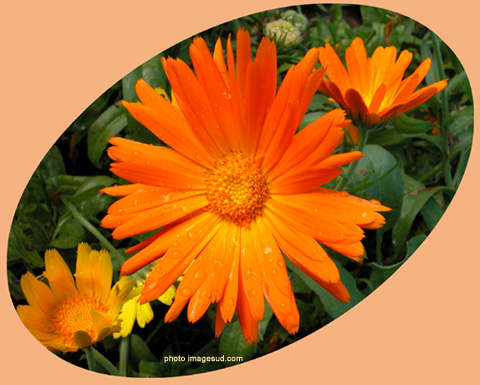Marigold Calendula officinalis
FIELDS OF CONCERN CALENDULA ARVENSIS
DAISY BELLIS Perennis
ASTERACEAE

These three plants are very common in Europe.
The marigold is a plant (rather cultivated), annual or perennial but short-lived, generally undeveloped but with foliage and provided mostly very typical flowers: orange, sometimes yellow, 4 to 6 cm in diameter.
The flowering period is prolonged, especially summer but you can find trouble in bloom almost all year.
The concern of the fields (photo at right) is smaller in size and is a ruderal plant found often on the edge of field, in the vineyards.
The daisy is perennial, small, with leaves in basal rosette, it flowers almost all year (especially in spring and summer in the north), very common in meadows, lawns, roadsides and highways.
The flowers and to a lesser extent the leaves of these three plants are medicinal.
COMPOSITION AND CHEMICAL PROPERTIES
The composition of flowers (flower head) of concern is quite well known but does not clearly explain its medicinal properties.
It includes:
* Flavonoids (including derivatives quercétol: anti-inflammatory)
* Triterpene compounds (alcohols): anti-inflammatory
* A little essential oil (to sesquiterpenes)
* Saponosides some relatives of ginseng saponins
* Pigments: carotenoids and xanthophylls
* Mucilage (in leaves)
The mother tincture is antibacterial in vitro, aqueous extract (containing saponins) is anti-inflammatory in vivo.
In vitro extracts concern accelerate the maturation and proliferation of lymphocytes, are active on HIV / AIDS (500 micrograms per ml) and reduce the activity of reverse transcriptase (an enzyme critical in the infection by the AIDS virus) .
USES
The concern is known as a medicinal plant since ancient Greece later it was cultivated in the medicinal garden of the Middle Ages.
We already knew as antipyretic, healing but also regulatory rules, topical for hemorrhoids, anti-icteric, anti-cancer ".
In the 19th century, North American surgeons advocated its use to speed healing, prevent infection and soothe the pain of surgical wounds.
Now it is mainly for external use that is retained.
- For torpid wounds, chronic ulcers
- Bruises and abrasions of the skin
- Skin inflammation with or without infection
- Superficial burns even secondary infections, dermatitis post radiotherapy
- As a disinfectant of the oropharynx as a mouthwash or gargle
- As a disinfectant in the female genital (vaginitis, vaginal discharge)
- As anti-inflammatory eye drops Anti-infectives
The internal use is more limited and must be limited to a few days, max 15 days (the order is slightly toxic):
* Inflammation-infection of the gastrointestinal tract (colitis, gastroduodenitis)
* In addition to outpatient treatment in cases of bruises
* In 2006 Spanish researchers have studied the properties of a new marigold extract: an aqueous extract having undergone a prolonged laser irradiation (LACE). In this study, the sample of interest is revealed inhibition of several types of cancer cells in mice. Inhibition of tumor development is between 70 and 100%, cancer cells are stopped in their growth and multiplication, some self-destruct (apoptosis). This study is isolated and, to my knowledge, no clinical applications.
The Marigold can eat, she brings original color and flavor to salads.
Dosage
Debridement of wounds, antisepsis of the oropharynx and genitalia:
* Infusion of the fresh plant: a handle 1 / 2 liter of warm water, 10 to 15 minutes
* Infusion of the dried plant: 1 to 2 teaspoons per cup of hot water, 10 to 15 minutes
* Tincture diluted 1 / 10 in distilled water or 1 / 3 compresses when infection and tissue shredding
In internal use (limited to 15 days):
* Infusion: One to three cups per day
* Tincture: 20 drops one to three times per day
There are commercially preparations with calendula cream, eye drops
sometimes with other plants under dermatological (eg wort, echinacea).
Calendula (marigold) is a constituent of many cosmetic products: soothing, protective against sunburn, dermatitis due to radiotherapy, as regenerating skin.
The concern of the field has the same medicinal properties as gardens.
The daisy is essentially vulnerary and healing (tea, tincture).
0 commentaires